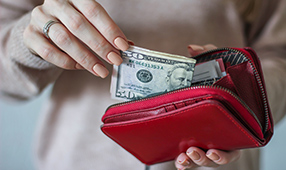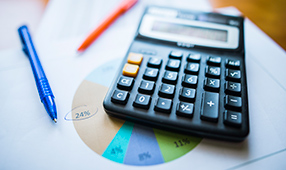Signs of inflation are just about everywhere: at the grocery store, the gas pump, restaurants, airlines and even car dealerships.
Inflation hit a 40-year high in late 2021 and has remained elevated ever since. Overall prices were up 9.1% in June 2022 over the previous year, according to the latest figures from the Bureau of Labor Statistics.1
To rein in runaway prices, the Federal Reserve is expected to continue raising its benchmark interest rate this year and next. Meanwhile, 85% of consumers polled by Forbes Advisor said they’ve changed their spending habits in response to rising prices. And more than three-quarters said they’ve spent more than they can afford or have little or no wiggle room left in their budgets, a sign of greater financial pressures ahead if prices continue to climb.2
If you’re looking for ways to save money now as the cost of living skyrockets, we’ve gathered some expert money tips that can help you cut common household expenses.
1. Set and follow a budget
When every penny counts, it’s smart to know where every penny goes. That means creating a budget and then making sure you stay within it by regularly tracking your spending. (Even if you already have a budget, it’s a good idea to update it to account for rising prices.)
Our “Build Your Budget in Six Easy Steps” workbook can help you create a budget, track where your money goes, and even identify unnecessary spending that you can cut. You may, for example, find that you can save money by canceling streaming services you rarely watch or a gym membership you don’t use.
2. Cut costs at the gas pump
By mid-summer 2022, the cost of fuel had pulled back from its highs, however steep gas prices remain a key contributor to today’s high inflation rate. Bicycling, taking public transportation or carpooling can reduce gas bills, but those simply aren’t options for everyone.
The next time you need to fill up, try using a free app—such as Gas Buddy, Gas Guru or Waze—to help find the cheapest gas within a reasonable driving distance.
Also, check to see if your grocery store offers a fuel discount program in partnership with gas stations. These kinds of incentive programs often offer about 10 cents off per gallon of gas for every $100 spent at the store, although limits and expiration dates vary.
Your driving habits also determine how fast your car burns fuel. The U.S. Department of Energy offers these gas-saving tips3:
- Unload the trunk. Remove unnecessary items from your trunk or back seat. The extra weight burns extra fuel. Every 100 excess pounds in your trunk reduces your miles per gallon (mpg) by 1%―or 5 cents per gallon (assuming a price of $4.87 per gallon of gas).
- Avoid prolonged idling. Turn off your engine if you’ll be stopped for more than 10 seconds. Idling wastes 2 to 5 cents of fuel per minute, depending on whether the air conditioning is running.
- Don’t carry cargo on your roof. A cargo box atop your car increases wind resistance and decreases fuel economy.
- Don’t drive aggressively. Extreme speeds, rapid acceleration and hard braking can lower your gas mileage by 15% to 30% on the highway, and 10% to 40% in stop-and-go traffic.
- Keep to the speed limit. Every 5 miles per hour (mph) you drive over 50 mph is like paying an extra 34 cents per gallon for gas.
- Consolidate errands. A warmed-up engine runs more efficiently than a cold one. Therefore, you can save on fuel by combining several errands into a single trip, rather than cold-starting your vehicle for multiple outings.
3. Take a bite out of grocery bills
After energy costs, food has seen the steepest price increases during this period of inflation. It’s easy to spot price hikes on groceries you regularly buy because your final bill at the register is higher than before. But the growing trend of “shrinkflation” is less obvious. That’s where manufacturers reduce the size of their products without lowering the price.
Try these practical tips to reduce your grocery bill:
- Plan your meals. Start by looking at what you already have in your pantry so you won’t unnecessarily spend money on items you already have. And with meat prices up 8.2% in June 2022 from the previous year, save money by incorporating a vegetarian dinner into your schedule once or twice a week.4
- Stick to a shopping list. This prevents impulse purchases that can add up and make a big dent in your food budget.
- Enroll in a store loyalty program. These programs often offer discounts at the cash register, provide coupons on items you regularly purchase, and might reduce the price of gas at participating stations.
- Buy in bulk. Join a warehouse club, such as Costco, where you pay less per unit for items you regularly use by buying in bulk. Avoid loading up on perishables, however, if you won’t be able to use them by their expiration dates. A bonus for NEA members: You’ll receive up to a $40 Digital Costco Shop Card when you sign up for a new Costco membership and enroll in membership auto renewal.
4. Pay down debt
If you have any loans or debt with a variable interest rate, you may find that your monthly payments have gone up. That’s because variable interest rates increase when the Fed raises its benchmark rate (usually within one or two billing statement cycles), according to Bankrate.com. During the first six months of 2022, the Fed increased the rate by 1.5 percentage points, and more increases are likely to come.
On the other hand, if you have a fixed interest rate, your issuer won’t automatically increase your rate as the Fed makes adjustments.
You can take steps to help lower the interest rates you’re receiving on your credit cards, car loans, personal loans, medical bills and more. First, make every payment on time, and also proactively take steps to improve your credit score.
Another option to explore for some debt types is to combine your existing debts into a single personal loan. Debt consolidation can help you save on interest, reduce your monthly payments and/or pay off your debts faster.
Plug your numbers into our customizable debt consolidation calculator to find options that may be available through the NEA Personal Loan program.
5. Earn cash back when shopping
One option is to sign up for some cash-back apps that give you a rebate when you shop at participating merchants. These apps earn commissions by steering buyers to the retailers, then share some of that money with the customers.
With the NEA Discount Marketplace, members can sign up for the Rakuten cash-back program. Rakuten partners with more than 3,500 stores, selling everything from clothing and pet food to electronics and sneakers. Your rewards can be paid to you via check or PayPal. Plus, NEA members can find exclusive cash-back offers negotiated specifically for you. Watch this short video to see how it works.
And while shopping anywhere online or in store, consider using a credit card that rewards you with miles, points or cash back.
6. Re-evaluate your auto and home insurance coverage needs
If it has been a while since you’ve reviewed your auto or homeowners insurance policy, take a little time to make sure your coverage still fits your needs.
Making some updates may result in lower monthly or annual premiums, which will help reduce the impact on your budget. One easy way to save money on auto and home insurance is to raise your deductibles. Just make sure you still have adequate coverage so you won’t end up paying a lot out of pocket in the event of an accident, damage repair or other claim.
“Bundling,” or buying auto and homeowners insurance together from the same company, typically can help reduce your overall premium costs.
You also can ask the insurer if you qualify for other discounts, such as a “good driver” discount if you haven’t had an accident in recent years, or a reduction in your homeowners premium for adding security devices to your residence.
7. Prepare for student loan payments
The U.S. government temporarily suspended payments and interest on federal student loans during the pandemic, but that debt relief is scheduled to end Aug. 31, 2022. It’s not clear as of June 2022 whether the suspension will be extended, but borrowers should plan now for how they will meet payments whenever they resume.
You might be able to lower your monthly payments, for example, by switching to a repayment plan that’s tied to your income. The government offers a few income-driven repayment plans that reduce your monthly payments, sometimes down to zero.
Teachers also may be eligible for Public Service Loan Forgiveness (PSLF), in which the balance on their federal loans is erased after they make 120 qualifying payments while working for a public service employer. After complaints from borrowers, the Department of Education recently revamped the complicated program, so more people will see their debt forgiven.
Check out the NEA Student Debt Navigator to run your numbers and search for options to lower or eliminate your student loan debt.
Note: Income-based repayment plans and student loan forgiveness programs apply only to federal loans. If you’re struggling to keep up with private student loans, contact your lender to see what options are available to reduce your payments.
8. Adjust your tax withholdings
The average tax refund at the end of the 2022 filing season was $3,039, according to the IRS.5 A big refund is nice, but it also means your paychecks are smaller throughout the year because too much money is being withheld for taxes.
If you regularly get huge tax refunds, you can reduce your withholding by revising your Form W-4 with your employer. Yes, you’ll likely receive a lower refund next tax season, but you’ll get more money back in each paycheck that you can put toward higher bills for gas, groceries, utilities and more.
1 Consumer Price Index, Bureau of Labor Statistics, June 2022.
2 Inflation Causing 85% Of Americans To Adjust Their Essential Purchases, Survey Finds, Forbes Advisor, June 2022.
3 Driving More Efficiently, U.S. Department of Energy.
4 Consumer Price Index, Bureau of Labor Statistics, June 2022.
5 2022 Filing Season Statistics, IRS, May 30, 2022.












